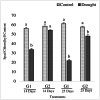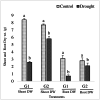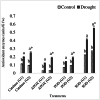UPLC-HRMS-based untargeted metabolic profiling reveals changes in chickpea (Cicer arietinum) metabolome following long-term drought stress
- PMID: 29532945
- PMCID: PMC7379973
- DOI: 10.1111/pce.13195
UPLC-HRMS-based untargeted metabolic profiling reveals changes in chickpea (Cicer arietinum) metabolome following long-term drought stress
Abstract
Genetic improvement for drought tolerance in chickpea requires a solid understanding of biochemical processes involved with different physiological mechanisms. The objective of this study is to demonstrate genetic variations in altered metabolic levels in chickpea varieties (tolerant and sensitive) grown under contrasting water regimes through ultrahigh-performance liquid chromatography/high-resolution mass spectrometry-based untargeted metabolomic profiling. Chickpea plants were exposed to drought stress at the 3-leaf stage for 25 days, and the leaves were harvested at 14 and 25 days after the imposition of drought stress. Stress produced significant reduction in chlorophyll content, Fv /Fm , relative water content, and shoot and root dry weight. Twenty known metabolites were identified as most important by 2 different methods including significant analysis of metabolites and partial least squares discriminant analysis. The most pronounced increase in accumulation due to drought stress was demonstrated for allantoin, l-proline, l-arginine, l-histidine, l-isoleucine, and tryptophan. Metabolites that showed a decreased level of accumulation under drought conditions were choline, phenylalanine, gamma-aminobutyric acid, alanine, phenylalanine, tyrosine, glucosamine, guanine, and aspartic acid. Aminoacyl-tRNA and plant secondary metabolite biosynthesis and amino acid metabolism or synthesis pathways were involved in producing genetic variation under drought conditions. Metabolic changes in light of drought conditions highlighted pools of metabolites that affect the metabolic and physiological adjustment in chickpea that reduced drought impacts.
Keywords: UPLC-HRMS analysis; drought; metabolic pathway; metabolites; water stress.
© 2018 The Authors Plant, Cell & Environment Published by John Wiley & Sons Ltd.
Conflict of interest statement
The authors declare no conflict of interest.
Figures







Similar articles
-
Comparative Physiological and Metabolic Analysis Reveals a Complex Mechanism Involved in Drought Tolerance in Chickpea (Cicer arietinum L.) Induced by PGPR and PGRs.Sci Rep. 2019 Feb 14;9(1):2097. doi: 10.1038/s41598-019-38702-8. Sci Rep. 2019. PMID: 30765803 Free PMC article.
-
Metabolic and physiological changes induced by plant growth regulators and plant growth promoting rhizobacteria and their impact on drought tolerance in Cicer arietinum L.PLoS One. 2019 Mar 4;14(3):e0213040. doi: 10.1371/journal.pone.0213040. eCollection 2019. PLoS One. 2019. PMID: 30830939 Free PMC article.
-
Comparative metabolomic profiling in the roots and leaves in contrasting genotypes reveals complex mechanisms involved in post-anthesis drought tolerance in wheat.PLoS One. 2019 Mar 11;14(3):e0213502. doi: 10.1371/journal.pone.0213502. eCollection 2019. PLoS One. 2019. PMID: 30856235 Free PMC article.
-
A Comprehensive Review on Chickpea (Cicer arietinum L.) Breeding for Abiotic Stress Tolerance and Climate Change Resilience.Int J Mol Sci. 2022 Jun 18;23(12):6794. doi: 10.3390/ijms23126794. Int J Mol Sci. 2022. PMID: 35743237 Free PMC article. Review.
-
Genome-wide identification of the fibrillin gene family in chickpea (Cicer arietinum L.) and its response to drought stress.Int J Biol Macromol. 2023 Apr 15;234:123757. doi: 10.1016/j.ijbiomac.2023.123757. Epub 2023 Feb 18. Int J Biol Macromol. 2023. PMID: 36805507 Review.
Cited by
-
Molecular Breeding and Drought Tolerance in Chickpea.Life (Basel). 2022 Nov 11;12(11):1846. doi: 10.3390/life12111846. Life (Basel). 2022. PMID: 36430981 Free PMC article. Review.
-
Differences in Physiological Responses of Two Oat (Avena nuda L.) Lines to Sodic-Alkalinity in the Vegetative Stage.Plants (Basel). 2020 Sep 11;9(9):1188. doi: 10.3390/plants9091188. Plants (Basel). 2020. PMID: 32933050 Free PMC article.
-
Supply of Methionine During Late-Pregnancy Alters Fecal Microbiota and Metabolome in Neonatal Dairy Calves Without Changes in Daily Feed Intake.Front Microbiol. 2019 Sep 19;10:2159. doi: 10.3389/fmicb.2019.02159. eCollection 2019. Front Microbiol. 2019. PMID: 31608024 Free PMC article.
-
Physiological and Metabolic Responses of Leymus chinensis Seedlings to Alkali Stress.Plants (Basel). 2022 Jun 2;11(11):1494. doi: 10.3390/plants11111494. Plants (Basel). 2022. PMID: 35684267 Free PMC article.
-
Unravelling the molecular mechanism underlying drought stress response in chickpea via integrated multi-omics analysis.Front Plant Sci. 2023 May 23;14:1156606. doi: 10.3389/fpls.2023.1156606. eCollection 2023. Front Plant Sci. 2023. PMID: 37287713 Free PMC article.
References
-
- Akhkha, A. , Tahar, B. , Hazem, K. , Parvaiz, A. , & Piotr, D. (2013). Chlorophyll fluorescence: A potential selection criterion for drought tolerance in selected durum wheat (Triticum durum Desf.) cultivars. SOAJ NanoPhotoBioSciences, 1, 147–156.
-
- Alia, S. P. P. , & Mohanty, P. (1997). Involvement of proline in protecting thylakoid membranes against free radical‐induced photodamage. Journal of Photochemistry and Photobiology B: Biology, 38, 253–257.
-
- Allakhverdiev, S. I. , & Murata, N. (2004). Environmental stress inhibits the synthesis de novo of proteins involved in the photodamage–repair cycle of photosystem II in Synechocystis sp.PCC6803. Biochimica et Biophysica Acta, Bioenergetics, 1657, 23–32. - PubMed
Publication types
MeSH terms
Substances
LinkOut - more resources
Full Text Sources
Other Literature Sources

